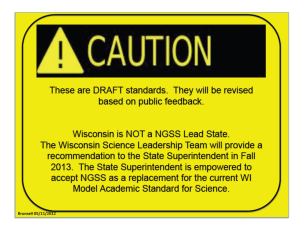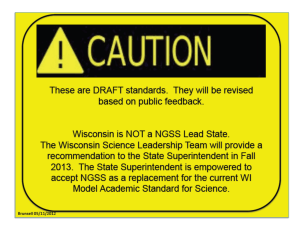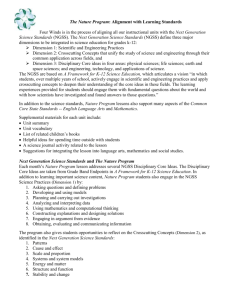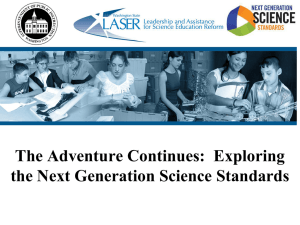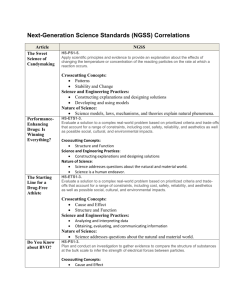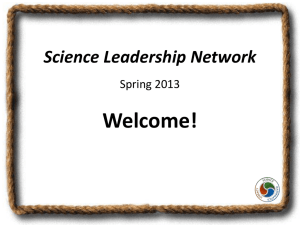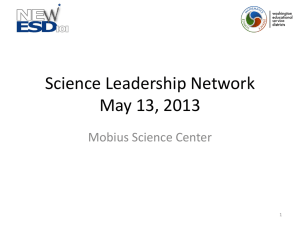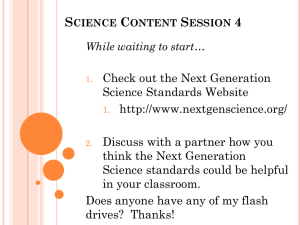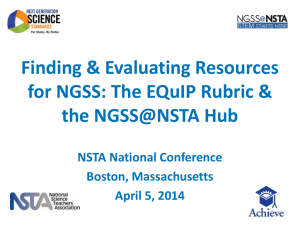Next Generation Science Standards January 2013 Public Review
advertisement
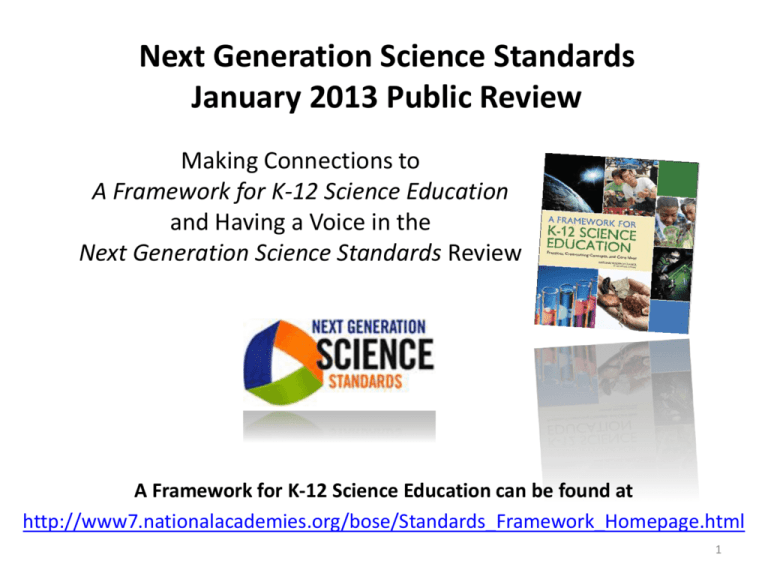
Next Generation Science Standards January 2013 Public Review Making Connections to A Framework for K-12 Science Education and Having a Voice in the Next Generation Science Standards Review A Framework for K-12 Science Education can be found at http://www7.nationalacademies.org/bose/Standards_Framework_Homepage.html 1 Welcome Presenters Ellen Ebert, Ph.D. Teaching and Learning Science Director Craig Gabler, Ph.D. ESD 113 Science Coordinator Sherry Schaaf, M.Ed. Science Educational Consultant Session Goals Review the core principles of A K12 Framework for Science Education Briefly discuss the major differences among the Framework, NGSS and WA Science Standards Discuss how to participate in the review of the public draft Review the anatomy of a standard Discuss the type of feedback needed Update Washington’s Role in the NGSS Timeline 1990s 1990s-2009 July 2010 – January 2013 January 2010 - July 2011 Phase II Phase I 4 National Research Council 5 Connections to research Research on How People Learn (HPL) Key Findings Key Findings for Students Key Findings for Teachers HPL 1 Students come to the classroom with preconceptions about how the world works. Surface student preconceptions and adjust instruction HPL 2 Students must have a deep foundation of usable knowledge and understand facts in the context of a conceptual framework. Understand the content and conceptual framework of instructional units HPL 3 Students must be taught explicitly to take control of their own learning by monitoring their progress. Teach students to think about their thinking. Vision for Science Education The framework is designed to help realize a vision for education in the sciences and engineering in which students, over multiple years of school, actively engage in science and engineering practices and apply crosscutting concepts to deepen their understanding of the core ideas in these fields. A Framework for K-12 Science Education p. 1-2 7 Principles of A Framework for K-12 Science Education •Children are born investigators •Understanding builds over time •Science and Engineering require both knowledge and practice •Connecting to students’ interests and experiences is essential •Focusing on core ideas and practices •Promoting equity How can the vision and principles of the Framework lead to a new vision of teaching with the NGSS? Organization of Framework Dimensions of the Framework – Scientific and Engineering Practices – Crosscutting Concepts – Disciplinary Core Ideas Realizing the Vision – Integrating the Three Dimensions – Implementation – Equity and Diversity – Guidance for Standards Development – Looking Toward the Future: Research to Inform K-12 Science Education Standards Background Eight Practices – Asking questions and defining problems – Developing and using models – Planning and carrying out investigations – Analyzing and interpreting data – Using mathematics and computational thinking – Constructing Explanations and Designing Solutions – Engaging in argument from evidence – Obtaining, evaluating, and communicating information Seven Crosscutting Concepts o o o o o Patterns Cause and effect Scale, proportion, and quantity Systems and system models Energy and matter: Flows, cycles, and conservation o Structure and function o Stability and change • Four Disciplinary Core Ideas: Life Science, Physical Science Earth and Space Science Engineering Promoting Equity • • • • Equalizing opportunities to learn Inclusive science instruction Making diversity visible Value multiple modes of expression 12 Developmental Progressions 9-12 6-8 3-5 K-2 Molecular model of biochemical reactions for matter and energy in food. Chemical reactions model for matter and energy in food, drawing on particle model of matter and energy transfer model. Simple food model: food consumed or produced is made of matter and provides energy for organisms. General needs model: Organisms get what they need to survive from the environment. 13 High School Science Shifts in Science Instruction with the NGSS Instruction organized around a limited number of core ideas: depth and coherence, not breadth of coverage. Core ideas will be revisited in increasing depth, and sophistication across years. Focus on connections: Careful construction of a storyline – helping learners build sophisticated ideas from simpler explanations using science evidence. Connections between scientific disciplines, using powerful ideas (nature of matter, energy) across life, physical, and earth science Instruction should involve learners in practices that develop, use, and refine the scientific ideas, not “explain” the science for students. Moving from A Framework to NGSS Integrating the 3 Dimensions Science & Engineering Practices Disciplinary Core Ideas Crosscutting Concepts 16 Architecture of a Standard 17 One Standard 18 Assessable Performance Expectations Foundation Boxes Connections Box Performance Expectations * Science PEs with engineering through a practice, DCI or crosscutting concept The performance expectation(s) where the practice is indicated Connections to other Disciplinary Core Ideas Connections to Common Core Responding to Feedback from all stakeholders 20 Integration of Engineering 21 Nature of Science 22 Navigating the Survey Accessing the survey – http://www.nextgenscience.org/ – Read front matter; note that there are options for how you can access the survey (we will go over) Key survey questions – Achieve is asking specific questions Is the PE too prescriptive or too vague? How grade appropriate is this PE? How relevant is this crosscutting concept to the core idea? How well would this PE demonstrate a student’s understanding of the DCI? 23 Approaches to Feedback • Follow one Disciplinary Core Idea vertically K12. (e.g. pick energy and see how the standards progress) • Examine standards in your grade band of expertise (e.g. K-5, MS, or HS) and +/- a grade • Examine just the engineering standards. • Just start clicking on random criteria in the search tool and see what you get.. aka NGSS roulette. All is too much Responding to the Survey Read the standards looking for the integration of each of the three dimensions (DCI, Crosscutting Concepts, and Science and Engineering Practices) Make a claim, provide evidence Respond in complete sentences Do not abbreviate or use acronyms What constitutes good feedback? • Draw example from spreadsheet of good & bad feedback – The DCI content in standard PS5 exceeds what is expected at the previous grade-level. Suggest that the learning progression be reexamined for coherency. Good. – An elementary cannot be expected to teach all of this content. Who is going to do the needed training? Bad. • Use another example from spreadsheet of good & bad feedback – Another specific issue: the argumentation practice does not show up until second grade (and then only once and once again in third grade), but the evidence is clear (e.g., Taking Science to School) that very young children (i.e., in preschool and kindergarten) can productively engage in argumentation. In the early grades, there is a classic imbalance towards observation (cf. our Piagetian history in the 60s / 70s). There should be deep use of explanation in K-2 as well as argumentation. Students need to be engaged in knowledge synthesis processes. Good. – Professional development would be needed for the support of the ETS framework in the disciplinary core ideas. Bad. 26 Survey Registration If you don’t complete the survey in one sitting, check email for your invitation code. Use this code to return to the survey. Introduction to the Survey Three Part Survey 1. Respondent information 2. General survey about all the standards 3. Specific questions about Performance Expectations that interest you Performance Expectations Questions Questions about K.SPM Online version of K.SPM NGSS Lead States Standards Connections Washington Standards Four Essential Academic Learning Requirements – – – – Systems Inquiry Application Domains • Life Science • Physical Science • Earth and Space Science Next Generation Science Standards • Science and Engineering Practices – Identifies 8 Practices • Subsumes WA Inquiry • Disciplinary Core Ideas – Adds Engineering and Technology • Subsumes WA Application • Crosscutting Concepts – Adds 7 crosscutting concepts • Subsumes WA Systems and Application OSPI Presentation to SBE: Next Gen. Science Thank you! • For updated information on the NGSS, please check http://www.k12.wa.us/Science/NGSS.aspx 33

